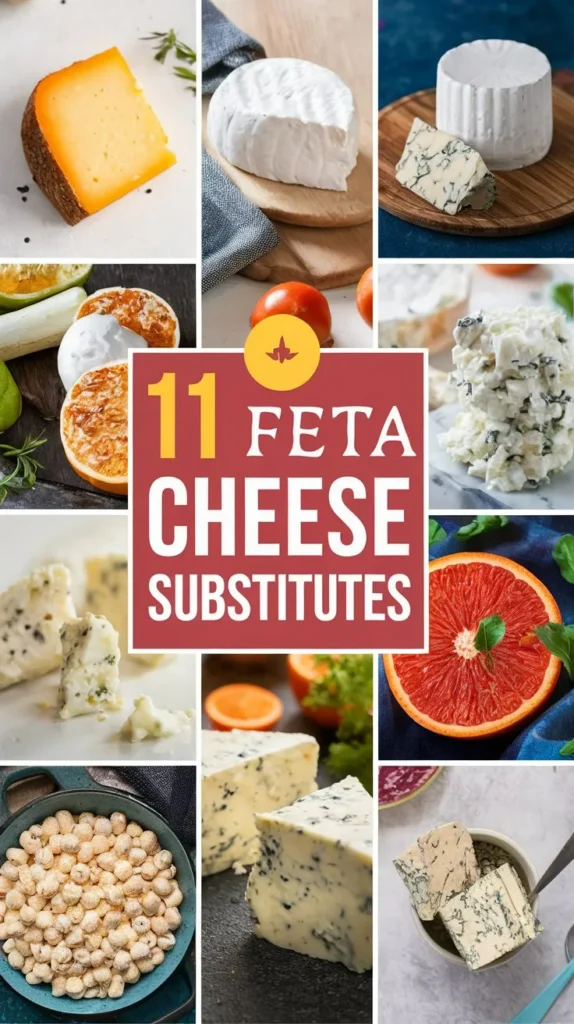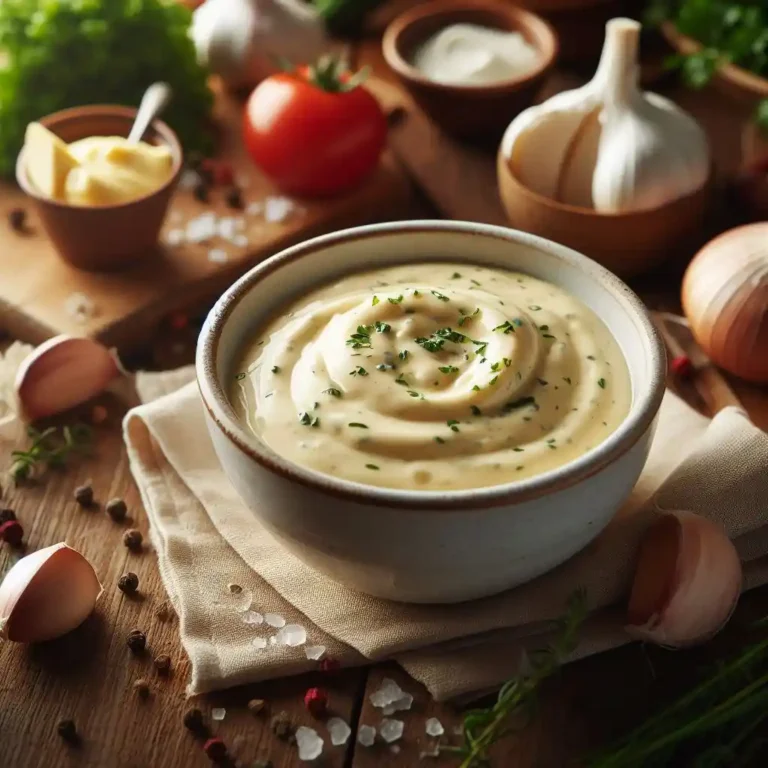11 Feta Cheese Substitutes to Add a Salty, Tangy Flavor
You’re looking to add a salty, tangy kick to your dishes, but feta cheese isn’t quite what you’re after. Don’t worry, you’re not limited to this one option. In fact, there are plenty of substitutes that can bring that same flavor profile to your table.
From creamy and mild to strong and pungent, the alternatives are vast. You might find yourself drawn to the tangy taste of goat cheese or the nutty flavor of Ricotta Salata.
But which one will you choose? The possibilities are endless, and we’re about to explore them – starting with the top 11 feta cheese substitutes that will elevate your cooking game.
At a Glance
- Goat cheese is a great feta substitute, offering a smoother texture and less salty flavor, perfect for salads, pasta, and vegetable toppings.
- Ricotta Salata and Bucheron French Cheese provide a nutty, crumbly alternative to feta, ideal for adding depth to salads and pasta dishes.
- Blue cheese packs a pungent punch, adding a strong, tangy flavor to recipes, but use it sparingly due to its boldness.
- For vegan options, marinated tofu or Sharp Pecorino Romano can mimic feta’s salty, tangy flavor in salads, pasta, and pizzas.
- Other feta substitutes like Mascarpone, Queso Fresco, and Manchego offer unique flavor profiles, from rich and decadent to zesty and crumbly, to enhance various dishes.

Creamy Goat Cheese Alternative
You’re likely drawn to feta’s tangy, salty flavor, but its crumbly texture can be off-putting in certain recipes.
This is where goat cheese comes in as a creamy alternative. Goat cheese originates from various parts of the world, including France, Spain, and the United States, offering diverse flavor profiles.
When it comes to textures, goat cheese can range from soft and spreadable to semi-soft and crumbly, making it an excellent substitute for feta in many dishes.
In particular, a young, soft goat cheese with a white rind can mimic feta’s tanginess while providing a smoother, more velvety texture.
This type of goat cheese is perfect for salads, pasta dishes, or as a topping for vegetables. Additionally, goat cheese tends to be less salty than feta, which can be beneficial for those watching their sodium intake.
Nutty Ricotta Salata Option
Ricotta Salata, an Italian cheese, brings a unique nutty flavor to the table, making it an intriguing substitute for feta.
You’ll appreciate its distinct taste, which is both sharp and slightly sweet, adding depth to your dishes. This Italian cheese is often produced in Sicily, where it’s made from sheep’s milk or a combination of sheep and goat’s milk.
The Sicilian production process involves salting and pressing the curd, which gives Ricotta Salata its characteristic firm texture and robust flavor.
When using Ricotta Salata as a feta substitute, you’ll notice it’s slightly milder, with a more delicate flavor profile. It’s an excellent choice for those who want to add a salty, tangy flavor without overpowering other ingredients.
You can crumble it over salads, pasta dishes, or use it as a topping for pizza. Ricotta Salata’s Italian heritage shines through in its rich, nutty flavor, making it a great option for those looking for a feta alternative that still packs a punch.
With its unique taste and versatility, Ricotta Salata is definitely worth trying in your next recipe.
Tangy Blue Cheese Substitute
By the time you’re searching for a feta substitute, you may have considered a tangy, pungent option to elevate your dishes.
That’s where blue cheese comes in. This tangy blue cheese substitute isn’t for the faint of heart, as it packs a pungent punch that will leave a lasting impression on your taste buds.
With its bold, tangy flavor profiles, blue cheese is an excellent choice for those seeking a feta alternative that will add depth and complexity to their recipes.
When using blue cheese as a substitute, keep in mind that it has a stronger flavor than feta, so start with a small amount and taste as you go.
This will help you achieve the perfect balance of flavors. Blue cheese nuances, such as its creamy texture and subtle sweetness, will also add a richness to your dishes that feta can’t match.
Whether you’re making a salad, pasta dish, or pizza, blue cheese is a tangy, pungent option that will take your culinary creations to the next level.
Crumbly Bucheron French Cheese
One notable alternative to feta is Crumbly Bucheron French Cheese, a semi-soft, cow’s milk cheese that boasts a rich, nutty flavor and a delightfully crumbly texture.
This artisanal cheese, originating from the French region of Auvergne, is crafted using traditional methods, resulting in a unique, rustic charm.
You’ll appreciate the subtle sweetness and hints of earthy undertones that balance out the tanginess, making it an excellent addition to salads, pasta dishes, or as a standalone snack.
When you incorporate Crumbly Bucheron into your recipes, you’ll be embracing the essence of French cuisine, known for its emphasis on quality, simplicity, and attention to detail.
Unlike mass-produced cheeses, this artisanal gem is crafted in small batches, ensuring an unparalleled level of craftsmanship and care.
As you savor the crumbly texture and rich flavors, you’ll understand why Crumbly Bucheron is a sought-after substitute for feta, offering a distinctive twist on traditional recipes.
Vegan Tofu Feta Replacement
You’ve explored the rich flavors of Crumbly Bucheron, but now it’s time to cater to the growing demand for plant-based alternatives.
As a vegan, you’re likely aware of the struggle to find a suitable feta substitute that replicates the tangy, salty flavor. That’s where tofu comes in – a versatile ingredient that can be marinated and seasoned to mimic the taste and texture of traditional feta.
When it comes to tofu marination methods, the key is to use a combination of acidic and savory flavors to break down the protein and create a cheese-like consistency.
Try using a mixture of lemon juice, apple cider vinegar, and nutritional yeast to give your tofu a tangy, umami flavor. You can also add some dried oregano and thyme to give it a Mediterranean twist.
For vegan feta recipes, you can use this marinated tofu in place of traditional feta in salads, pasta dishes, and even as a topping for vegan pizzas.
Simply crumble the tofu into small pieces and mix it with some olive oil, garlic, and herbs, and you’ll have a convincing feta substitute that’s sure to please even the most discerning palates.
Briny Halloumi Cheese Standin
Crisp and creamy, halloumi cheese is a staple in Cypriot cuisine, and its distinctive brininess can be a challenge to replicate in a vegan substitute.
You might be thinking, “How can I achieve that signature salty kick in a plant-based version?” Stop your search! Halloumi cheese substitutes are designed to capture the essence of this beloved Cyprus cuisine staple.
When searching for a halloumi substitute, you’ll want to prioritize options that can hold their own against the high heat of a grill, just like traditional grilled halloumi.
Opt for plant-based cheeses that boast a high melting point, ensuring they won’t disintegrate or become too soft when cooked. Additionally, pay attention to the ingredient list – a good halloumi substitute should contain natural ingredients that evoke the tangy, salty flavor you’re after.
Ultimately, the best halloumi substitute for you’ll depend on your personal taste preferences and cooking methods.
But with a little experimentation and patience, you can enjoy the bold, briny flavor of halloumi in a vegan-friendly format that’s sure to impress.
Sharp Pecorino Romano Choice
With its sharp, salty bite, Pecorino Romano is a natural fit as a feta substitute, and its distinctive flavor profile makes it an excellent choice for those seeking a vegan alternative.
You’ll find that this Italian cheese, made from sheep’s milk, embodies the country’s rich traditions and is often aged to perfection.
- Pecorino Romano’s sharpness is due to its aging process, which can range from five to eight months, giving it a granular texture and intense flavor.
- Aged varieties of Pecorino Romano have a more pronounced umami taste, making it a great addition to pasta dishes, salads, and pizzas.
- This cheese is often used in Italian cuisine to add depth and complexity to recipes, making it an excellent substitute for feta in many dishes.
- When choosing a Pecorino Romano, look for a pale yellow color and a strong, pungent aroma, indicating a well-aged and flavorful cheese.
- As a vegan alternative, you can also find plant-based Pecorino Romano options, made from nuts or soy, that mimic the real thing’s unique flavor profile.
Salty Crottin Goat Cheese Swap
Beyond the familiar tang of feta, Salty Crottin Goat Cheese offers a distinctive flavor profile that makes it an intriguing substitute in many recipes.
You’ll find that this French goat cheese has a rich history, dating back to the 16th century when it was first produced in the Loire Valley.
Its creamy texture and tangy taste, similar to feta, make it an excellent addition to salads, pasta dishes, and pizzas.
What sets Salty Crottin apart is its unique aging process, which involves coating the cheese in salt and ash to develop a distinctive white rind.
This process gives the cheese a salty, slightly sweet flavor that’s both familiar and exotic.
As a feta substitute, Salty Crottin Goat Cheese brings a level of sophistication to your dishes, thanks to its roots in French cheese culture.
When using it in place of feta, you’ll find that it pairs beautifully with fresh herbs, olives, and sun-dried tomatoes.
With its unique flavor profile and rich history, Salty Crottin Goat Cheese is an excellent choice for those looking to elevate their dishes with a tangy, salty twist.
Creamy Mascarpone Cheese Option
This Italian cream cheese, Mascarpone, takes a dramatic departure from feta’s tangy bite, instead offering a rich, buttery flavor that’s both decadent and indulgent.
While it may not replicate the salty, crumbly texture of feta, Mascarpone brings its own unique benefits to the table. You’ll find that its creamy consistency adds a luxurious touch to dishes, making it an excellent addition to recipes where you want to elevate the flavor and texture.
- Mascarpone’s rich flavor profile pairs well with sweet ingredients, making it an excellent choice for desserts or fruit-based dishes.
- Its creamy texture provides a nice contrast to crunchy or crispy elements, adding depth to salads or appetizers.
- Mascarpone benefits from being a versatile cheese, suitable for both sweet and savory applications.
- You can use it as a substitute in recipes where you want to add a rich, indulgent flavor without the tang of feta.
- Keep in mind that Mascarpone has a higher calorie count than feta, so use it sparingly if you’re watching your diet.
Zesty Queso Fresco Alternative
Mexican cuisine’s crown jewel, Queso Fresco, brings a bold, zesty flavor to the table, making it an excellent substitute for feta cheese in many recipes.
You’ll love how its crumbly texture and tangy taste add depth to dishes like tacos, salads, and pasta.
Queso Fresco’s history dates back to the 16th century, when Spanish conquistadors introduced cheese-making techniques to Mexico.
Over time, Mexican farmers developed their own unique recipe, using cow’s milk to create a cheese that’s both creamy and crumbly.
When using Queso Fresco as a feta substitute, keep in mind that it’s slightly milder, so you may want to add a pinch of salt or a squeeze of lime juice to bring out its flavors.
Its Mexican roots also make it an ideal pairing for bold flavors like chipotle peppers, cilantro, and lime zest.
Whether you’re making a traditional Mexican dish or experimenting with new flavors, Queso Fresco is an excellent choice to add a zesty, salty kick.
Rich Manchego Cheese Substitute
Savoring the richness of flavor, you’ll find Manchego cheese to be a sophisticated substitute for feta, elevating your dishes to new heights.
This Spanish cheese, produced from the milk of Manchega sheep grazing on the rolling hills of Spanish farms, boasts a rich, nutty flavor profile that’s both earthy and refined.
With a firm, crumbly texture, Manchego adds depth and complexity to a variety of dishes, from salads to pasta, and even pizza.
Some key benefits of using Manchego as a feta substitute include:
- A more nuanced flavor profile, with hints of caramel and toasted nuts
- A richer, creamier texture that holds its own against bold flavors
- A more elegant presentation, with its distinctive yellow-orange hue
- A perfect pairing with sweet or savory ingredients, from figs to olives
- A cheese that’s both accessible and exotic, perfect for adventurous palates
FAQs
Can I Make My Own Feta Cheese Substitute at Home?
You can make your own feta cheese substitute at home by experimenting with cultured tofu, tweaking its flavor profile to match the tangy, salty taste you crave – it’s doable, but be prepared for trial and error.
Are Feta Cheese Substitutes Suitable for Lactose Intolerant Individuals?
You’ll be relieved to know that many lactose-free options and dairy-free alternatives are available, making it possible for you to enjoy feta-like flavors without the dairy discomfort, but be sure to choose a reputable brand that meets your dietary needs.
Do Feta Cheese Substitutes Have the Same Nutritional Value?
You wonder if feta cheese substitutes have the same nutritional value as traditional feta; honestly, they often don’t, with varying Feta nutrition facts, but dairy-free alternatives can still provide a similar salty, tangy taste, making them a decent option.
Can I Use Feta Cheese Substitutes in Baked Goods and Desserts?
You can experiment with feta substitutes in baked goods and desserts, but be cautious of altering taste profiles and flavor combinations; some may work, like goat cheese in cheesecakes, while others might clash, so it’s trial-and-error to find the perfect balance.
Are Feta Cheese Substitutes More Expensive Than Traditional Feta?
You’re wondering if feta cheese substitutes break the bank, right? Honestly, they can be pricier than traditional feta, but the cost comparison depends on the brand and quality, with some substitutes costing up to 20% more.










DK Jacks is a passionate food enthusiast, recipe developer, and culinary explorer. With a love for both traditional and innovative flavors, DK brings a fresh perspective to the kitchen. When not experimenting with new ingredients, you’ll find DK capturing food moments through the lens or sharing cooking tips with fellow foodies.🍽️📸✨







